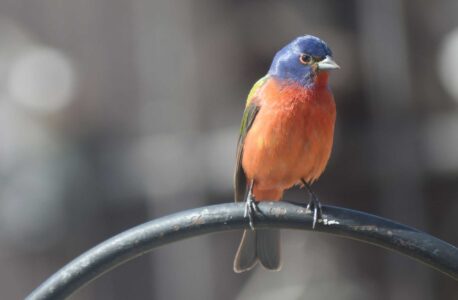A colorful visitor: Southern bird appears in north Dickinson
Northwoods Notebook
- A PAINTED BUNTING, a bird that normally can be found no farther north than southern Kansas and South Carolina, turned up this week at a home in Felch Township in Dickinson County. The males of this species, which is related to the native indigo buntings, are considered among the most colorful birds in North America. (Betsy Bloom/Daily News photo)
- A PAINTED BUNTING, a bird that normally can be found no farther north than southern Kansas and South Carolina, turned up this week at a home in Felch Township in Dickinson County. (Betsy Bloom/Daily News photo)
- A PAINTED BUNTING, a bird that normally can be found no farther north than southern Kansas and South Carolina, turned up this week at a home in Felch Township in Dickinson County.(Betsy Bloom/Daily News photo)

A PAINTED BUNTING, a bird that normally can be found no farther north than southern Kansas and South Carolina, turned up this week at a home in Felch Township in Dickinson County. The males of this species, which is related to the native indigo buntings, are considered among the most colorful birds in North America. (Betsy Bloom/Daily News photo)
FELCH TOWNSHIP — Yes, this is a real bird.
And he is very far from home.
When Sandy Chartier glanced out her glass deck doors Tuesday and saw this sitting on her bird feeders, it left her “dumbfounded.”
“I couldn’t believe it,” the longtime Felch Township resident said.
The gaudy, finch-sized bird made itself so at home on her deck the rest of the day that Chartier was able to get several decent photos with her phone, as it hopped around on the doormat and bellied up to the clear feeder she has attached by suction cups to the window.

A PAINTED BUNTING, a bird that normally can be found no farther north than southern Kansas and South Carolina, turned up this week at a home in Felch Township in Dickinson County. (Betsy Bloom/Daily News photo)
She then turned to Facebook with the photos. “Anyone know what kind of bird this is?” she asked, adding, “I’ve been feeding birds for years and have never had one here like this before.”
The answer: It’s the kind of bird people get very excited about seeing here, because there’s a reason why you’ve never had one like it before.
While considered fairly common in the southern U.S., the well-named painted bunting normally nests no farther north than southeastern Kansas or South Carolina. So the odds of one turning up in far northern Michigan are long.
Much less at a home well off the beaten path in Felch Township.
Vagrants like this bunting can be caused by a number of factors, said Ryan Brady, a Wisconsin Department of Natural Resources conservation biologist.

A PAINTED BUNTING, a bird that normally can be found no farther north than southern Kansas and South Carolina, turned up this week at a home in Felch Township in Dickinson County.(Betsy Bloom/Daily News photo)
Severe weather like a hurricane or snowstorm might force the bird wildly off course. Climate conditions, such as drought, or other issues that affect the food supply may make them seek a better situation. Young animals, including birds, sometimes are driven to disperse, seek out their own territories.
But this likely is a case of “overshooting,” when a southern species that winters in Mexico and Central America keeps pushing north well past its usual range during spring migration.
Because of their plumage and fondness for bird feeders, male painted buntings regularly get noticed each year when they wander off course. A male turned up in Ashland County, where Brady lives, just last summer. A quick glance at eBird, Cornell Lab of Ornithology’s website for reporting sightings throughout the world, showed at least a dozen records of painted buntings in the Upper Peninsula, though none for Dickinson County, Brady said.
The females, a uniform lime green, probably stray into the north as well but go unnoticed and underreported.
Still, it can be considered a rare treat to have one, Brady said.
“A male painted bunting? That has to be in the top three colorful birds (in North America),” he said, adding, “A painted bunting looks fake. It looks like it’s been dipped in paint.”
Painted buntings come from a particularly colorful family, Cardinalidae. As the name suggests, this family includes the familiar northern cardinal, but also indigo buntings, rose-breasted grosbeaks and scarlet tanagers, all of which come north to nest in late spring each year.
But none of those are quite as decked out as the male painted bunting.
Painter, as Chartier has named him, was still around all day Friday. “Now I just talk to him when he comes to the window,” she said. “I have a hard time calling him a he, he’s so pretty.”
Chartier seems to have a good seed mix, as a host of other species — brown-headed cowbirds, common grackles, red-winged blackbirds, white-crowned and chipping sparrows, purple finches, goldfinches and more — just in a couple of hours Wednesday. She’s put out more feeders to keep up with the traffic.
But Painter definitely is the star while he remains.
“I just love the fact he chose my area,” Chartier said.
She added, “I was thinking how sad I would be when he doesn’t show up any more … but he has his own life to lead.”







